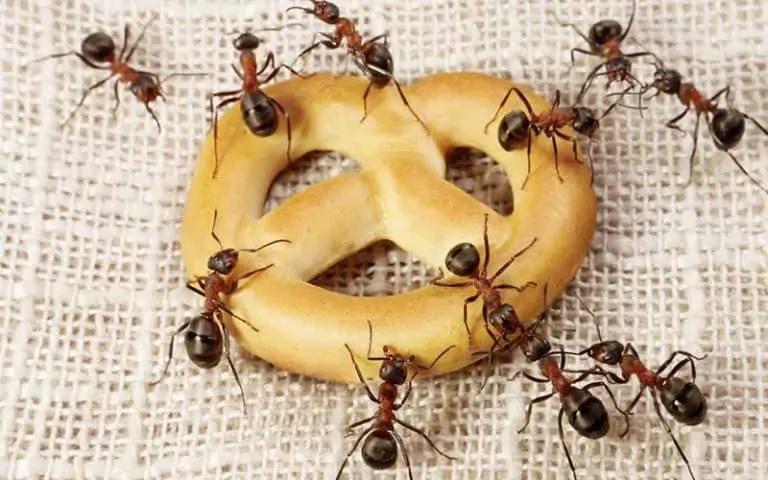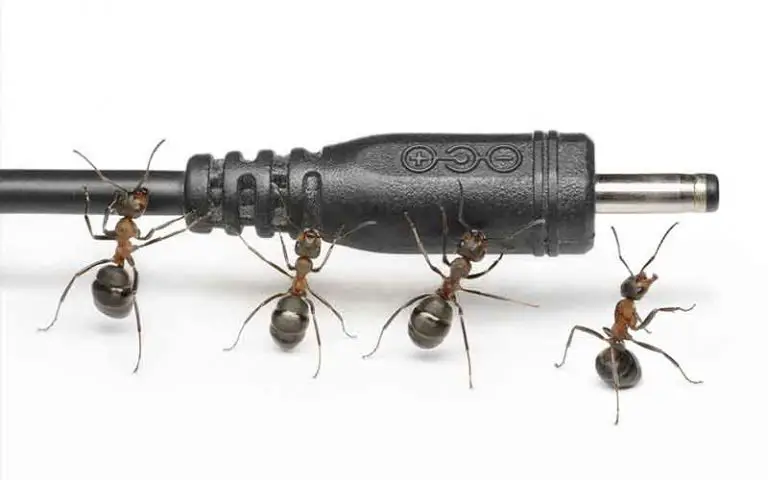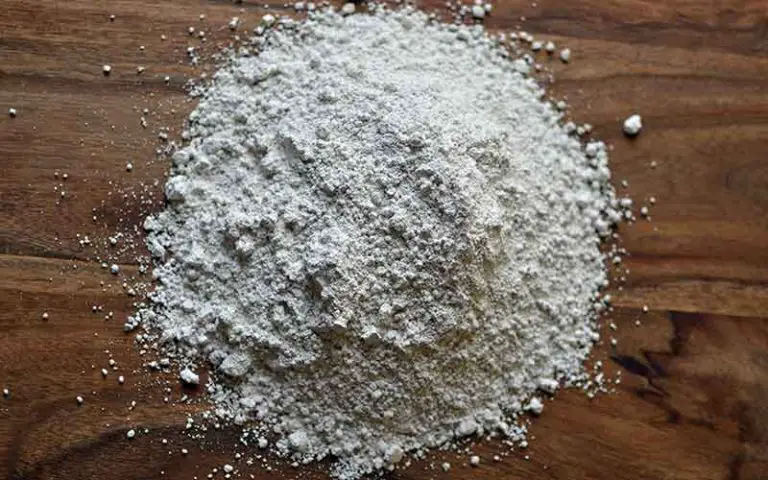Drain Flies or Fruit Flies? Identification And Differences
When it comes to pest control, there are many different types of flies that can be problematic for homeowners. Two of the most common that show up around the home are drain flies and fruit flies. While they may seem like similar insects, their appearance and habits actually vary quite a bit.
Knowing what type of fly you’re dealing with can help you develop a more effective pest control solution.
The easiest way to identify each is: Drain flies are a little larger than fruit flies. Drain flies have wings with a unique pattern of dark veins while fruit flies have clear wings. Fruit flies have distinct red eyes if looked at up close.
Understanding Their Different Life Cycles
There are distinct differences between drain flies and fruit flies. The first step to identifying them is to understand a little about their life cycles. Both types of flies begin life as eggs laid on fermenting material, such as the rotting remains of fruits or vegetables. Drain fly eggs are greenish-white in color, while fruit fly eggs have a reddish tint.
The next stage of development is the larvae (colloquially called maggots). Drain fly larvae are slightly longer and thinner than fruit fly larvae. They’re also a lighter color, usually yellowish-white or greenish. Fruit fly larvae, on the other hand, have a distinctive red hue and appear much fatter than drain flies’ white worms.
Interest in the maggots for each kind of fly lies in their eating habits. Drain flies feed on decaying plant matter, while fruit flies are drawn to fresh fruits and vegetables. This is what draws fruit flies to homes with overripe produce in the kitchen, but it also means that drain flies aren’t nearly as common indoors because they’re not attracted to the same food.
The final stage in a drain fly’s life cycle is pupation when it develops wings and becomes an adult. Fruit flies go through the same metamorphosis, but their transformation takes place inside a protective covering known as a puparium. This structure is left behind after the fruit fly emerges as an adult.

How Long Do They Both Live?
Knowing how long each of these types of flies lives is important for developing an effective pest control plan. Drain fly eggs hatch in about one or two days, while fruit fly eggs take around five to seven. The larvae stage of drain flies lasts four to eight days, while fruit fly larvae can survive up to 12 days.
The pupal stage takes two to four days for fruit flies and five to eight for drain flies. Adult fruit flies live an average of 40-50 days, while adult drain flies usually only survive for between 7-20 days.
Being able to detect the distinctive signs of fly activity is important, but it can be difficult because drain flies and fruit flies often show up at different times. Fruit flies tend to appear in the spring when produce starts ripening, while drain flies usually arrive in late summer or early fall. During winter, they both hibernate and then return indoors in the spring.
How To Identify Drain Flies
Drain flies like dark, humid places and frequently end up living in a drain, which might be a floor or a sink drain, sink overflow, or another place that is accessible to plumbing. Although they don’t bite, their presence can cause asthma in certain individuals.
Drain flies look light gray or tan with a dark border around their wings. They are about ⅛-inch long and have moth-like bodies with fuzzy hairs and antennae.
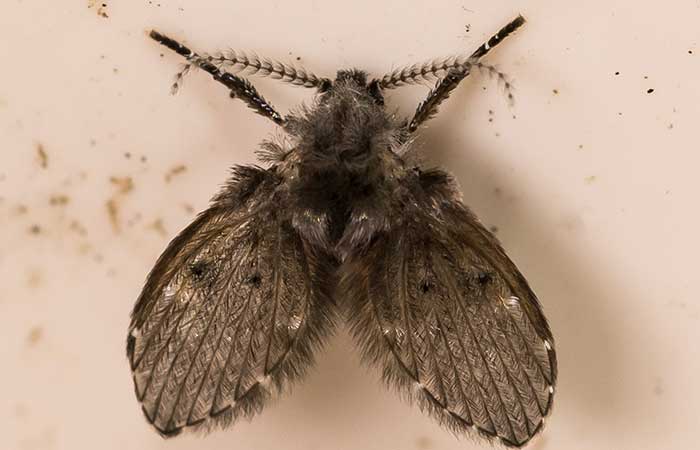
Drain flies are also known as moth flies, sewage flies, or filter flies. They have a lot of hairs on their bodies and wings. When crushed, they leave a powdery smear.
Adult drain flies tend to look like typical houseflies, while fruit flies resemble smaller versions of wasps. A distinguishing feature is their ability to hover in mid-air and walk on vertical surfaces, which most other types of flies can’t do.
How To Identify Fruit Flies
Fruit flies are certainly the most common flying insects that will bother you in the kitchen. They are attracted to fresh and decaying fruit, as well as sugary fluids and alcohol.
A distinguishing feature of Fruit flies is their eye color which varies from red to dark brown. They typically grow to be about 3⁄16-inch long and look like a housefly but much smaller, and their body is shiny and has a metallic color.
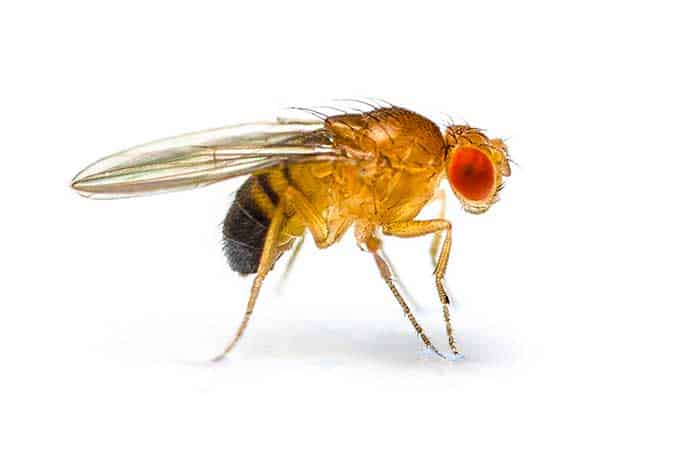
What Attracts Drain Flies?
Drain flies are found in bathrooms, kitchens, and any other area that contains a build-up of grime and dirt. Moisture is a big attraction for drain flies so they can be seen in the sewer drains, garbage disposals, and other areas where food waste is present and a wet, damp environment.
What Attracts Fruit Flies?
Fruit flies are attracted to ripened or fermenting fruits and vegetables. They also like beer, soda pop, and other sugary beverages that produce alcohol when yeast acts upon them. Fruit fly larvae can be found in garbage disposals or garbage containers.
How To Get Rid of Drain Flies
Drain flies, like other kinds of flies, can be killed with a contact insecticide. Spray the drain fly larvae directly to kill them and continue treatment until no more larvae are seen surfacing.
However, it is best to identify where the drain fly pupae are in order to treat that area. Adult foods and their larvae do the most damage, so treating them during the early stages of infestation is important.
How To Get Rid Of Fruit Flies
Fruit flies are attracted to fermenting substances so these need to be cleaned up quickly. Make sure any food waste is taken out of the house daily and never leave bananas, tomatoes, or other fruits on countertops for more than a few days.
Conclusion
Having a good understanding of fly life cycles and identifying characteristics can help you figure out which kind of household pest is bugging you. If the culprit is a drain fly, then overripe produce that’s been left sitting around for an extended period will need to be cleaned up or disposed of properly.
Fruit flies require more involved measures like trimming infested fruits and vegetables, removing their source of food, and working with pest control professionals to seal up entry points like weep holes in the foundation.

